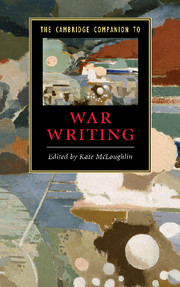Book contents
- Frontmatter
- Introduction
- Part I Themes
- Part II Influences
- Part III Poetics
- 8 Medieval warfare
- 9 Early modern war writing and the British Civil Wars
- 10 The eighteenth century and the romantics on war
- 11 American Revolutionary War writing
- 12 The Victorians and war
- 13 The American Civil War
- 14 The First World War: British writing
- 15 The First World War: American writing
- 16 The Spanish Civil War
- 17 The Second World War: British writing
- 18 The Second World War: American writing
- 19 American writing of the wars in Korea and Vietnam
- 20 The Cold War and the “war on terror”
- Index
11 - American Revolutionary War writing
from Part III - Poetics
Published online by Cambridge University Press: 28 January 2010
- Frontmatter
- Introduction
- Part I Themes
- Part II Influences
- Part III Poetics
- 8 Medieval warfare
- 9 Early modern war writing and the British Civil Wars
- 10 The eighteenth century and the romantics on war
- 11 American Revolutionary War writing
- 12 The Victorians and war
- 13 The American Civil War
- 14 The First World War: British writing
- 15 The First World War: American writing
- 16 The Spanish Civil War
- 17 The Second World War: British writing
- 18 The Second World War: American writing
- 19 American writing of the wars in Korea and Vietnam
- 20 The Cold War and the “war on terror”
- Index
Summary
It can be easy to forget that the American Revolution included a long and difficult armed conflict. Scholars of the period, in both historical and literary studies, have focused almost entirely on the ideas that drove the American colonists to resist British imperial rule and underpinned the new form of government they adopted in that process, the so-called experiment in democracy. The contrast to the historical memory of the American Civil War is instructive. The symbols and images of the Civil War are for the most part specifically related to the bloodshed of war: battlefields such as Gettysburg and Petersburg and events such as the burning of Atlanta and Richmond have become the enduring emblems of the conflict that divided the states. Although battlefields are not entirely absent from the memorializing of the Revolution, the national imagination has been captured more by political sites such as Independence Hall, Mount Vernon, Monticello, and documents such as the Declaration of Independence, the United States Constitution, and the Bill of Rights. Moreover, images such as the signing of the Declaration of Independence (disseminated widely as a popular engraving), the Liberty Bell, and the Boston Tea Party focus attention on the political motivations for independence and push the war into the background, as if the war were incidental to the Revolution and not essential to its success. War, in other words, remains at the center of the cultural memory of the Civil War, whereas it has been pushed to the margins of the story of the American Revolution.
- Type
- Chapter
- Information
- The Cambridge Companion to War Writing , pp. 126 - 134Publisher: Cambridge University PressPrint publication year: 2009

